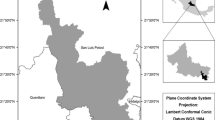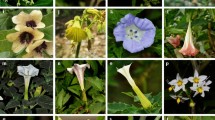Summary
Nervilia plicata is a morphologically variable terrestrial orchid with a wide geographic range in tropical Asia. Several forms have previously been recognised as distinct taxa due primarily to differences in the size, outline and colour of perianth parts. As a first step towards understanding the links between floral polymorphism, pollination ecology and genetic differentiation within the N. plicata complex, we sought to ascertain whether distinct colour morphs in 18 populations in Thailand and South China were correlated with discrete differentiation in macro- or micromorphological characters. Perianth morphology was studied in the field and under stereomicroscopy, and labellum anatomy was examined using light microscopy and scanning electron microscopy. Phenetic analyses comprising Principal Coordinate Analysis (PCoA) and Unweighted Pair Group Method with Arithmetic Mean (UPGMA) of 16 characters revealed four clusters representing distinct floral morphs — pink morph with small, entire labellum; purple morph with large, undulate labellum; white and yellow morph with large, entire labellum; and white and yellow morph with small, entire labellum — among which the size, shape, density and periclinal wall surface of dome-shaped papillae in the secretory zone of the labellar adaxial epidermis varied discontinuously. Our results provide evidence of micromorphological differentiation among N. plicata populations in parts of tropical Asia. Pollinator observations and analyses of genetic diversity are required to establish whether this variation is of any ecological, evolutionary or taxonomic significance.






Similar content being viewed by others
References
Abdel Khalik, K. & Osman, A. K. (2007). Seed morphology of some species of Convolvulaceae from Egypt (Identification of species and systematic significance). Feddes Repert. 118: 24 – 37.
Adhikari, B. & Wallace, L. E. (2014). Does the Platanthera dilatata (Orchidaceae) complex contain cryptic species or continuously variable populations? Pl. Syst. Evol. 300: 1465 – 1476.
Ascensão, L., Francisco, A., Cotrim, H. & Pais, M. S. (2005). Comparative structure of the labellum in Ophrys fusca and O. lutea (Orchidaceae). Amer. J. Bot. 92: 1059 – 1067.
Averyanov, L. V. (2011). Nervilia gracilis — A new orchid species from northern Vietnam. Taiwania 56: 50 – 53.
Beath, D. D. N. (1996). Pollination of Amorphophallus johnsonii (Araceae) by carrion beetles (Phaeochrous amplus) in a Ghanian rain forest. J. Trop. Ecol. 12: 409 – 418.
Chen, J.-Y., Wu, J.-B., Huang, B.-S. & Yeh, M.-S. (2006). Quantitative analysis of physiological compound adenosine in three periods from Taiwan’s Nervilia species. J. Agric. Assoc. China 7: 223 – 233.
Chen, X. & Gale, S. W. (2011). Nervilia. In: X. Y. Wu, P. H. Raven & Hong D. Y. (eds), Flora of China, 25: 197 – 201. Science Press, Beijing and Missouri Botanical Garden Press, St. Louis.
Curry, K. J., McDowell, L. M., Judd, W. S. & Stern, W. L. (1991). Osmophores, floral features, and systematics of Stanhopea (Orchidaceae). Amer. J. Bot. 78: 610 – 623.
Davies, K. L. & Stpiczyńska, M. (2012). Comparative labellar anatomy of resin-secreting and putative resin-mimic species of Maxillaria s.l. (Orchidaceae: Maxillariinae). Bot. J. Linn. Soc. 170: 405 – 435.
de Melo, M. C. & Borba, E. L. (2011). Morphological variability in rupicolous species of the Acianthera prolifera complex (Orchidaceae) occurring in southeastern Brazil. Pl. Syst. Evol. 293: 135 – 145.
Eltz, T., Sager, A. & Lunau, K. (2005). Juggling with volatiles: exposure of perfumes by displaying male orchid bees. J. Comp. Physiol. A 191: 575 – 581.
Eltz, T., Whitten, W. M., Roubik, D. W. & Linsenmair, K. E. (1999). Fragrance collection, storage, and accumulation by individual male orchid bees. J. Chem. Ecol. 25: 157 – 176.
Francisco, A. & Ascensão, L. (2013). Structure of the osmophore and labellum micromorphology in the sexually deceptive orchids Ophrys bombyliflora and Ophrys tenthredinifera (Orchidaceae). Int. J. Pl. Sci. 174: 619 – 636.
Gale, S. W. (2007). Autogamous seed set in a critically endangered orchid in Japan: pollination studies for the conservation of Nervilia nipponica. Pl. Syst. Evol. 268: 59 – 73.
Gale, S. W., Duangjai, S., Li, J., Ito, Y., Watthana, S., Termwutthipreecha, P., Cheuk, M. L. & Suddee, S. (2018). Integrative analyses of Nervilia (Orchidaceae) section Linervia reveal further undescribed cryptic diversity in Thailand. Syst. Biodivers. 1: 1 – 20.
Gale, S. W., Li, J., Kinoshita, A. & Yukawa, T. (2015). Studies in Asian Nervilia (Orchidaceae) V: Nervilia futago, a cryptic new species from Southwest Japan confirmed by morphological, cytological, and molecular analyses. Syst. Bot. 40: 413 – 425.
Gale, S. W., Maeda, A., Chen, C. I. & Yukawa, T. (2010). Inter-specific relationships and hierarchical spatial genetic structuring in Nervilia nipponica, an endangered orchid in Japan. J. Plant Res. 123: 625 – 637.
Gale, S. W., Chen, C. I. & Kuroiwa, N. (2006). Observations on the phenology and reproductive success of the critically endangered Nervilia nipponica (Orchidaceae) in Kochi Prefecture, Japan. Acta Phytota. Geobot. 57: 81 – 93.
Gale & Watthana, S. (2014). Nervilia. In: T. Santisuk & K. Larsen (eds), Flora of Thailand, 12: 553 – 569. Forest Herbarium, Bangkok.
Gigord, L. D. B., Macnair, M. R. & Smithson, A. (2001). Negative frequency-dependent selection maintains a dramatic flower color polymorphism in the rewardless orchid Dactylorhiza sambucina (L.) Soò. PNAS 98: 6253 – 6255.
Govaerts, R., Bernet, P., Kratochvil, K., Gerlach, G., Carr, G., Alrich, P., Pridgeon, A. M., Pfahl, J., Campacci, M. A., Holland Baptista, D., Tigges, H., Shaw, J., Cribb, P., George, A., Kreuz, K. & Wood, J. (2018). World checklist of Orchidaceae. retrieved from http://apps.kew.org/wcsp/
Hamilton, G. (2013). Nervilia plicata in Sabah. Malesian Orchid J. 11: 39 – 42.
Hammer, Ø., Harper, D. A. T. & Ryan, P. D. (2001). PAST: paleontological statistic software package for education and data analysis. Palaeontol. Electronica 4: 1 – 9.
Haridas, R., Thangapandian, V. & Thomas, B. (2014). Phytochemical evaluation of a medicinal orchid: Nervilia plicata (Andrews) Schltr. IJPDT 4: 204 – 209.
Harris, J. G. & Harris, M. F. (2001). Plant Identification Terminology: An Illustrated Glossary. Payson, Spring Lake Publishing, Utah.
Hedrén, M. & Nordström, S. (2009). Polymorphic populations of Dactylorhiza incaranata s.l. (Orchidaceae) on the Baltic island of Gotland: morphology, habitat preference and genetic differentiation. Ann. Bot. 104: 527 – 542.
Hickey, M. & King, C. (2002). The Cambridge Illustrated Glossary of Botanical Terms. Cambridge University Press, Cambridge.
Hooker, J. D. (1885). Pogonia pulchella. Curtis’s Bot. Mag. 111: t. 6851.
Hooker, J. D. (1890). Flora of British India 6. Orchideae to Cyperaceae. L. Reeve & Co., London.
Hu, A. Q., Gale, S. W., Kumar, P., Saunders, R. M. K., Sun, M. & Fischer, G. A. (2017). Preponderance of clonality triggers loss of sex in Bulbophyllum bicolor, an obligately outcrossing epiphytic orchid. Molec. Ecol. 26: 3358 – 3372.
Humeau, L., Micheneau, C., Jacquemyn, H., Gauvin-Bialecki, A., Fournel, J. & Pailler, T. (2011). Sapromyiophily in the native orchid, Bulbophyllum variegatum, on Réunion (Mascarene Archipelago, Indian Ocean). J. Trop. Ecol. 27: 591 – 599.
Johansen, D. A. (1940). Plant Microtechnique. McGraw-Hill, New York.
Kumar, E. D. & Janardhana, G. R. (2011). Antidiabetic activity of alcoholic stem extract of Nervilia plicata in streptozotocin-nicotinamide induced type 2 diabetic rats. J. Ethnopharmacol. 133: 480 – 483.
Neiland, M. R. M. & Wilcock, C. C. (1998). Fruit set, nectar reward, and rarity in the Orchidaceae. Amer. J. Bot. 85: 1657 – 1671.
Pagag, K., Roy, D. K. & De, L. C. (2014). Additions to the orchid Flora of Meghalaya, India. MIOS J. 15: 6 – 10.
Pansarin, L. M., de Moraes Castro, M. & Sazime, M. (2009). Osmophore and elaiophores of Grobya amherstia (Catasetinae, Orchidaceae) and their relation to pollination. Bot. J. Linn. Soc. 159: 408 – 415.
Pearce, N. & Cribb, P. J. (2002). In: The Orchids of Bhutan. Flora of Bhutan: including a record of plants from Sikkim and Darjeeling. Vol. 3, Part 3. Edinburgh and Royal Government of Bhutan, Royal Botanic Gardens.
Peter, C. I. & Johnson, S. D. (2014). A pollinator shift explains floral divergence in an orchid species complex in South Africa. Ann. Bot. 113: 277 – 288.
Pettersson, B. (1989). Pollination in the African species of Nervilia (Orchidaceae). Lindleyana 4: 33 – 41.
Pettersson, B. (1990). Studies in the genus Nervilia (Orchidaceae) in Africa. Nord. J. Bot. 9: 487 – 497.
Pettersson, B. (1991). The genus Nervilia (Orchidaceae) in Africa and the Arabian Peninsula. Orchid Monogr. 5: 1 – 90.
Pridgeon, A. M., Cribb, P. J., Chase, M. W. & Rasmussen, F. N. (2005). Genera Orchidacearum, Vol. 4: Epidendroideae (Part I). Oxford University Press, Oxford.
Chase, M. W. & Stern, W. L. (1983). Ultrastructure of osmophores in Restrepia (Orchidaceae). Amer. J. Bot. 70: 1233 – 1243.
Raju, V. S., Reddy, C. S., Reddy, K. N., Rao, K. S. & Bahadur, B. (2008). Orchid wealth of Andhra Pradesh, India. Proc. AP Acad. Sci. 12: 180 – 192.
Raskoti, B. B. & Ale, R. (2010). Nervilia makinnoni Duthie and Nervilia plicata (Andrews) Schltr. (Orchidaceae): new records for flora of Nepal. Botanica Orientalis. J. Pl. Sci. 6: 109 – 110.
Rohlf, F. J. (2000). NTSYS-pc: numerical taxonomy and multivariate analysis system, version 2.1. Exeter Software, New York.
Song, X.-Q., Meng, Q.-W. & Luo, Y.-B. (2007). New records of orchids from Hainan, China. Acta Phytotax. Sin. 45: 324 – 328.
Su, H. (2000). Nervilia. In: T.-C. Huang (ed.), Flora of Taiwan 5: 976 – 981. Editorial Committee of the Flora of Taiwan, Taipei.
Tan, K.-H., Nishida, R. & Toong, Y.-C. (2002). Floral synomone of a wild orchid, Bulbophyllum cheiri, lures Bactrocera fruit flies for pollination. J. Chem. Ecol. 28: 1161 – 1172.
Teixeira, S. D. P., Borba, E. L. & Semir, J. (2004). Lip anatomy and its implications for the pollination mechanisms of Bulbophyllum species (Orchidaceae). Ann. Bot. 93: 499 – 505.
Thainurak, H. & Suwanthada, C. (2008). Conservation of terrestrial orchid, Nervilia I. survey, collection and growth study. Agric. Sci. J. 39: 149 – 153.
Vallius, E., Salonen, V. & Kull, T. (2004). Factors of divergence in co-occurring varieties of Dactylorhiza incarnata (Orchidaceae). Pl. Syst. Evol. 248: 177 – 189.
Whitney, H. M., Bennett, K. V., Dorling, M., Sandbach, L., Prince, D., Chittka, L. & Glover, B. J. (2011). Why do so many petals have conical epidermal cells? Ann. Bot. 108: 609 – 616.
Wiemer, A. P., More, M., Benitez-Vieyra, S., Cocucci, A. A., Raguso, R. A. & Sersic, A. N. (2009). A simple floral fragrance and unusual osmophore structure in Cyclopogon elatus (Orchidaceae). Pl. Biol. 11: 506 – 514.
Xiaohua, J., Dezhu, L., Zongxin, R. & Xiaoguo, X. (2012). A generalized deceptive pollination system of Doritis pulcherrima (Aeridinae: Orchidaceae) with non-reconfigured pollinaria. BMC Plant Biol. 12: 67.
Acknowledgements
We would like to thank Phra Sakhon Thammawutho, Petch Tripetch, Jiraporn Meewasana, Khomsan Sritan, Woranuch La-ongsri, Uthen Thongnak, Sirilak Radbouchoom, Siriphong Komani, the officers at Tad Mok Waterfall, Chiang Mai, and the nuns at Wat Weluwan, Kanchanaburi, for helping us with field work and specimen collection. KK gratefully acknowledges Aporn Ketjarun, Somchai Ketjarun and the Science Achievement Scholarship of Thailand (SAST) for financial support, Wipawee Nilapaka for providing accommodation during field work, Wandee Inta, Pirada Sumanon and Panthamith Rattanakrajang for their help with data analysis, and Thaya Jenjittikul and Lalita Kethirun for supplying equipment. The authors are grateful to the editor and two anonymous referees for providing valuable comments to improve the manuscript. This project was supported by Mahidol University.
Author information
Authors and Affiliations
Corresponding author
Additional information
Publisher’s Note
Springer Nature remains neutral with regard to jurisdictional claims in published maps and institutional affiliations.
Rights and permissions
About this article
Cite this article
Ketjarun, K., Traiperm, P., Suddee, S. et al. Labellar anatomy of the Nervilia plicata complex (Orchidaceae: Epidendroideae) in tropical Asia. Kew Bull 74, 1 (2019). https://doi.org/10.1007/s12225-018-9788-8
Accepted:
Published:
DOI: https://doi.org/10.1007/s12225-018-9788-8




